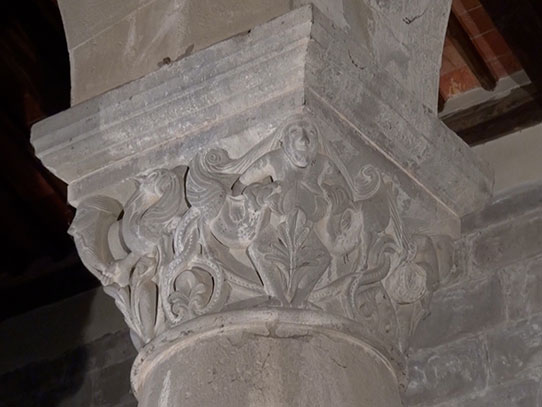THE CAPITAL of the DRAGONS
left nave, fourth column
Close in style to the preceding capital, this one shows four figures, three females and one male, placed on its four corners, all surrounded by dragons whose tails are intertwined, and whose paws rest on shoots that form leaves and cover the private parts of the human figures. Mons. Valente Moretti (2004) called this the capital of Hell, as did Fornasari (2005), identifying the male figure as Lucifer and the females with the allegory of lust. However, the old man, according to Gandolfo (2003), would not be committing the sin of lust because of his advanced age, and therefore he avoids this sin but not by his own merit. The scholar proposes this reading after comparison to a similar figure on the pulpit of the church of S. Maria del Lago in Moscufo (Pescara), of 1159, executed in stucco by the sculptor Nicodemo.
This capital, like the others, can be variously interpreted. The female figures have their hands resting on the necks of the dragons, and their arms partially embrace them, as if they are being sheltered and nursed. The pose is very similar to the iconography of the potnia theron, the Mistress of the Animals, which appears in prehistoric cultures and recurs with variations throughout the centuries. One finds this motive also in the Romanesque era: in Emilia, for example, it appears on a capital from the church of San Giovanni in Borgo (now in the Civic Museum of Pavia, room X), where the woman holds by their necks two dragons with entwined tails; and in the Portal of the Zodiac of the Sacra di San Michele in Val di Susa, by the architect and sculptor Nicholaus (active until 1139), there are two women who are nursing serpents, also on a capital. Nicholaus, or Niccolò, was from Piacenza, and the area of Emilia is relevant because this capital in Gropina, along with the preceding one, has been attributed stylistically to him or his circle (Gandolfo 2003). Active in Pavia, Ferrara and Verona around the time of the first Romanesque building phase in Gropina, Nicholaus was influenced by Wiligelmo and by the sculpture of the Languedoc, and Salmi noticed the affinity with this region of France especially for this capital. The winding shoots and small elements in relief, such as the long straight lines of the hair, appear also in the capitals of Gislebertus and hs workshop at Saint-Lazare di Autun (c. 1125-1145).
The female figures nursing dragons or serpents have been interpreted as allegories of lasciviousness, but also as Mother Earth nourishing all living creatures. This last hypothesis would completely alter the reading of the entire capital, no longer a representation of Inferno but of life in the making, with the figure of the old man, vexed or unhappy, in the act of tearing at his beard, as an opposing symbol: that of old age, life reaching its end. In that vein, the figure cited by Gandolfo on the pulpit of Moscufo is part of the cycle of life, where it represents the last stage. The absence of the usual symbolic attributes of Lucifer, such as the horns and his expression, also argues against the Allegory of Hell. Sometimes Romanesque architectural sculpture gives art historians great interpretive problems, but these centuries-old challenges are motives for much of the enthusiasm and interest in this profession.


